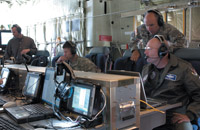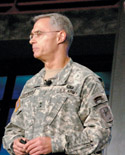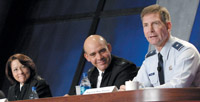Leaders Talk Tough About Interoperability
 |
| Gen. Victor E. “Gene” Renuart Jr., USAF (r), commander, North American Aerospace Defense (NORAD) Command and U.S. Northern Command (NORTHCOM), observes a demonstration of a communications package situated aboard a C-130 aircraft. The Joint Communications Support Element conducted the event that demonstrated how military organizations can provide communications support to civilian law enforcement agencies. Without interoperability, this type of support is impossible, military leaders agree. |
Interoperability remains an illusive goal that the
As the military has adopted network-centric warfare as its mantra and purchased the systems to make it a reality, the problems—and what is at stake—have grown exponentially. Understanding the cost as well as what has been lost is causing
Candid discussions about these topics took place at MILCOM 2007 in October as close to 6,000 attendees met to discuss the current state of technology, interoperability and the needs of the warfighters. AFCEA International and the IEEE Communications Society co-sponsored the conference; Harris Corporation hosted the event. The dialogue revolved around the fact that at a time when sharing data is more critical than ever, information sharing and interoperability are inextricably intertwined. The two are necessary not only to communicate in the battlespace but also to predict what will happen and what needs to be done in response, military leaders agreed.
 |
| Maj. Gen. (P) Jeffrey A. Sorenson, USA, then special assistant to the Secretary of the Army, and now chief information officer/G-6, describes some of the challenges the U.S. Army faces with interoperability. Two continuing issues are proprietary systems and lack of standards. |
Leaders from all of the services including the U.S. Coast Guard as well as from the homeland defense and homeland security sectors candidly admitted how interoperability problems emerged and persist. Put simply, evolution and revolution have led to confusion. Legacy systems continue to reside throughout the services, and their owners and users refuse to give them up. Combatant commands and other military organizations are using their own funds to buy technical solutions to local problems without regard for the higher level interoperability needs.
In addition, programs are being combined to increase efficiency, but the interoperability ball is being dropped in the process. While the interoperability of new solutions is in most cases assured, many times those systems are not moved into the field expeditiously. Ironically, the current rotation schedule of troops into operations also aggravates the problem as warfighters coming into the theater of operations bring with them new equipment that may not have been tested with the old. And questions remain about how to field technologies today while staying on track with the long-term vision.
The challenges are compounded when other organizations are added to the mix. For example, the military may want or need to collaborate with the U.S. Department of Homeland Security, a compilation of 22 agencies all with their own systems. The National Guard Bureau, which is now an operational force rather than a strategic force, supports 54 states and territories, and as Maj. Gen. Alan L. Cowles, USCG, director, command, control, communications and computers, National Guard Bureau, put it, “We don’t task; we just ask,” which leaves attaining interoperability at the mercy of the organizations the Guard assists.
In addition to the purely logistical causes for the current lack of interoperability, deeper reasons exist. The roots of organizations that are being compelled to collaborate and cooperate are buried under years of tradition of not sharing information. As a result, the policies and doctrines as well as the tactics, techniques and procedures needed to facilitate information sharing, and therefore the interoperability requirements have not been written. This leads many military leaders to ask who’s in charge and to pose the idea of an information-sharing architect.
Although no organization can point a finger at another for the interoperability problems, all of them agree that the effects are evident. The inability to communicate during the September 11, 2001, terrorist attacks and slow response in the wake of Hurricane Katrina illustrate the confusion that results. In some cases, missed communications during the Hurricane Katrina effort delayed disaster relief as 50,000 soldiers could talk to their individual states but not to each other.
On an even larger scale, the lack of leadership is causing problems to snowball. In current operations, it has resulted in wasted funds as multiple systems are being created to solve a single problem. For example, Gen. Lance L. Smith, USAF (Ret.), former commander of the U.S. Joint Forces Command (JFCOM), revealed that 11 language-to-language systems were sent into the field. Worse yet, seven Blue Force Tracking systems that were not able to communicate with each other were sent into
 |
| MILCOM 2007 Executive Chair Robert K. Henry, chief operating officer and executive vice president, Harris Corporation (c), moderates the “Fireside Chat” about interoperability between Dale W. Meyerrose (l), associate director of national intelligence and chief information officer, Office of the Director of National Intelligence, and John G. Grimes, assistant secretary of defense for networks and information integration. |
Driven by the need for both effectiveness and efficiency, other efforts also are under way. Dale W. Meyerrose, associate director of national intelligence and chief information officer, Office of the Director of National Intelligence, pointed out that the amount of funding required to sustain the thousands of cross-connections between the intelligence community and the U.S. Defense Department is “horrendous.” As a result, 34 cross-domain information-sharing initiatives between the two organizations have been developed; five of them have been signed. The intelligence community and the Defense Department also will be taking advantage of each other’s strengths. The former will look to the latter for the standards created through the Net-Centric Enterprise Services; the department will be examining the intelligence community’s search capabilities, Meyerrose revealed.
To improve interoperability for the National Guard, the organization is installing the Joint Incident Site Communications Capability (JISCC). When work is complete, each state will have a system; as of October, 50 percent of the systems had been installed.
On the topic of leadership, Brig. Gen. Peter M. Aylward,
Gen. Smith revealed that the capabilities portfolios now in place in the military may solve the problem of commanders purchasing equipment on their own. JFCOM is in charge of the command and control portfolio, so it has access into each organization’s budget. As a result, equipment will not be funded until it is proved to work with all other systems, Gen. Smith said. “This has huge implications for corporations. If you don’t play with others, if you’re one of those 11 language-to-language translators, someone at JFCOM will look at you and choose to drop you,” he stated.
 |
| Vice Adm. Nancy E. Brown, USN, director, command, control, communications and computer systems, J-6, the Joint Staff, and Rear Adm. Kendall L. Card, USN (c), director, command control systems, J-6, NORAD and NORTHCOM, listen to Brig. Gen. David B. Warner, USAF, director, command and control programs, Defense Information Systems Agency, as he explains the need for coalition partners in an operations center to possess the capability to communicate with the headquarters in their own nations so they can take action. |
The lack of interoperability has implications that extend beyond being able to fight or respond to crises in a network-centric manner. John G. Grimes, assistant secretary of defense for networks and information integration, pointed out that a lack of interoperability leads to confusion, increasing the vulnerability of
Grimes expressed concern about a number of areas related to information technology in general. He stated that the Defense Department still does not have its collaborative tools under control, and that he is very concerned about the security of data at rest. In addition, the department’s unclassified networks have been under constant attack, which leads him to believe in the need for the globalization of information assurance.
As military leaders discussed solving interoperability problems created in the past, they made apparent their awareness of what seamless interoperability can mean to operations in the future. Gen. Smith pointed out that the
Once the Defense Department has resolved its interoperability problems, the next step will be to ensure that the department’s systems interoperate with those of the Department of Homeland Security. This could potentially lead to federal, state and local networks becoming part of the military’s Global Information Grid. In addition, the Joint Tactical Radio System could become the official radio for all first responders.
While this type of unfettered communications capability appears to be desirable, Brig. Gen. Randal D. “Randy” Fullhart, USAF, deputy chief, Central Security Service, National Security Agency (NSA), drew an analogy to the roads of ancient
“People can influence what goes on in the world, and there is a collision between news and intelligence. The myth is that analysts have too much information. What is needed is the right information. You’re part of the Roman road building, and the NSA is doing more and delivering more to leaders than ever before,” the general stated.
Alluding to MILCOM’s location in




Comments